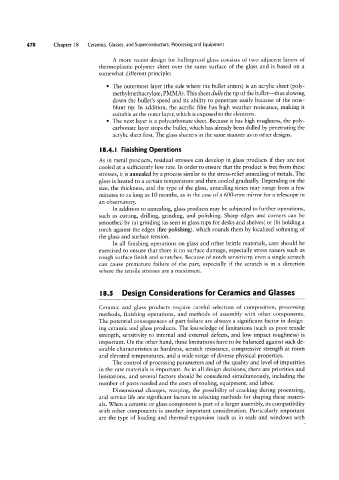Page 498 - 04. Subyek Engineering Materials - Manufacturing, Engineering and Technology SI 6th Edition - Serope Kalpakjian, Stephen Schmid (2009)
P. 498
78 Chapter 18 Ceramics, Glasses, and Superconductors: Processing and Equipment
A more recent design for bulletproof glass consists of two adjacent layers of
thermoplastic polymer sheet over the same surface of the glass and is based on a
somewhat different principle:
° The outermost layer (the side where the bullet enters) is an acrylic sheet (poly-
methylmethacrylate, PMMA). This sheet dulls the tip of the bullet-thus slowing
down the bullet’s speed and its ability to penetrate easily because of the now-
blunt tip. In addition, the acrylic film has high weather resistance, making it
suitable as the outer layer, which is exposed to the elements.
° The next layer is a polycarbonate sheet. Because it has high toughness, the poly-
carbonate layer stops the bullet, which has already been dulled by penetrating the
acrylic sheet first. The glass shatters in the same manner as in other designs.
l8.4.I Finishing Operations
As in metal products, residual stresses can develop in glass products if they are not
cooled at a sufficiently low rate. In order to ensure that the product is free from these
stresses, it is annealed by a process similar to the stress-relief annealing of metals. The
glass is heated to a certain temperature and then cooled gradually. Depending on the
size, the thickness, and the type of the glass, annealing times may range from a few
minutes to as long as 10 months, as in the case of a 600-mm mirror for a telescope in
an observatory.
In addition to annealing, glass products may be subjected to further operations,
such as cutting, drilling, grinding, and polishing. Sharp edges and corners can be
smoothed by (a) grinding (as seen in glass tops for desks and shelves) or (b) holding a
torch against the edges (fire polishing), which rounds them by localized softening of
the glass and surface tension.
In all finishing operations on glass and other brittle materials, care should be
exercised to ensure that there is no surface damage, especially stress raisers such as
rough surface finish and scratches. Because of notch sensitivity, even a single scratch
can cause premature failure of the part, especially if the scratch is in a direction
where the tensile stresses are a maximum.
|8.5 Design Considerations for Ceramics and Glasses
Ceramic and glass products require careful selection of composition, processing
methods, finishing operations, and methods of assembly with other components.
The potential consequences of part failure are always a significant factor in design-
ing ceramic and glass products. The knowledge of limitations (such as poor tensile
strength, sensitivity to internal and external defects, and low impact toughness) is
important. On the other hand, these limitations have to be balanced against such de-
sirable characteristics as hardness, scratch resistance, compressive strength at room
and elevated temperatures, and a wide range of diverse physical properties.
The control of processing parameters and of the quality and level of impurities
in the raw materials is important. As in all design decisions, there are priorities and
limitations, and several factors should be considered simultaneously, including the
number of parts needed and the costs of tooling, equipment, and labor.
Dimensional changes, warping, the possibility of cracking during processing,
and service life are significant factors in selecting methods for shaping these materi-
als. When a ceramic or glass component is part of a larger assembly, its compatibility
with other components is another important consideration. Particularly important
are the type of loading and thermal expansion (such as in seals and windows with

